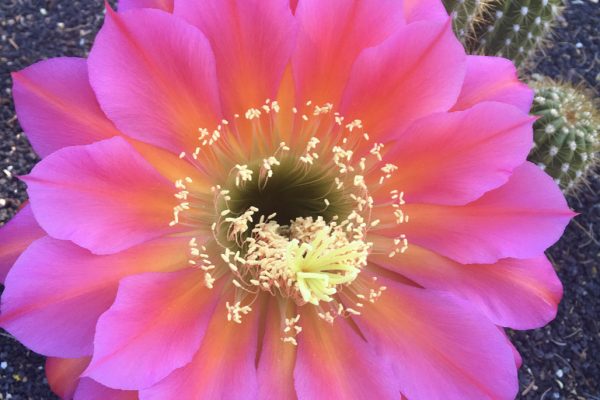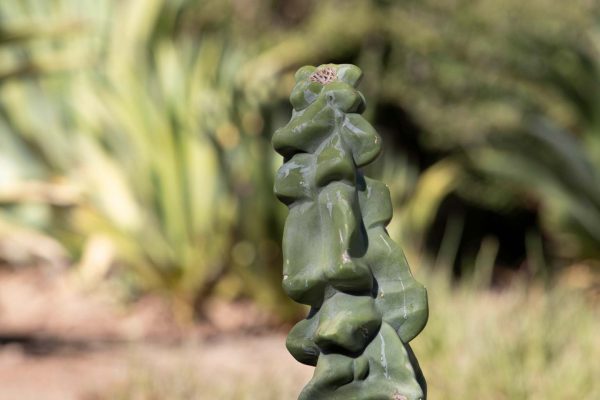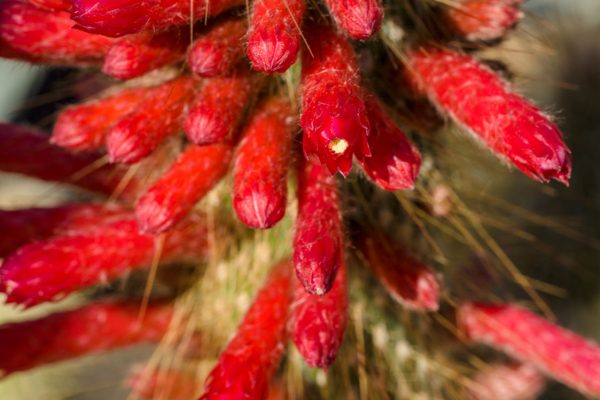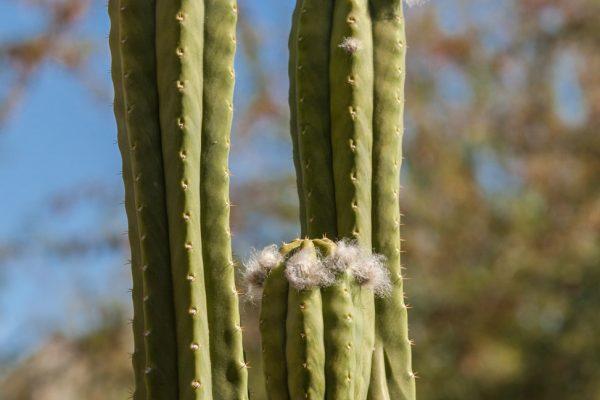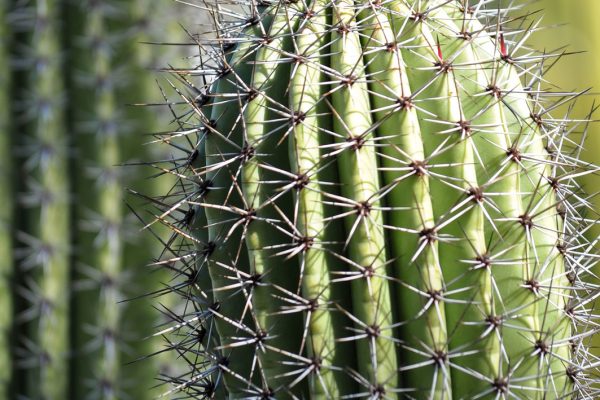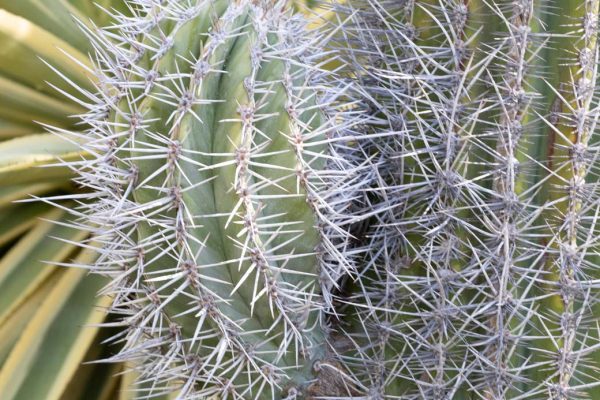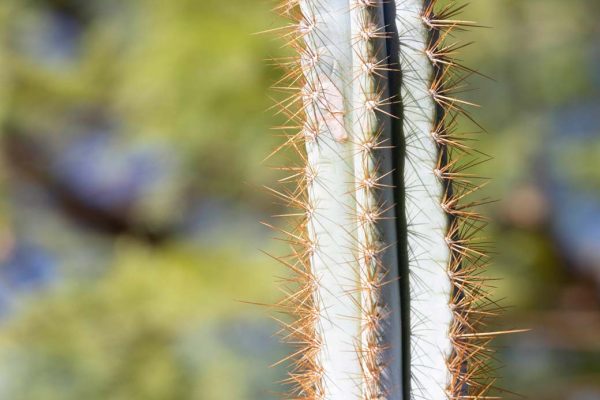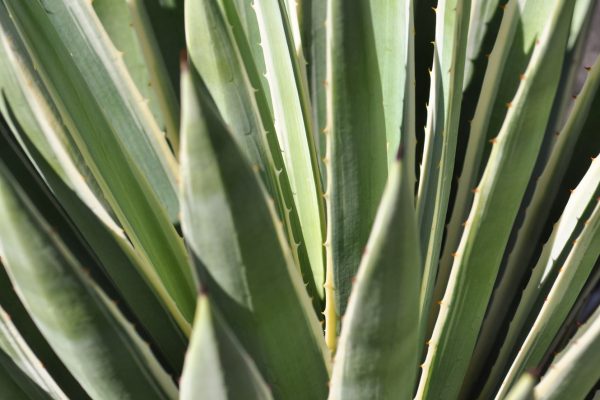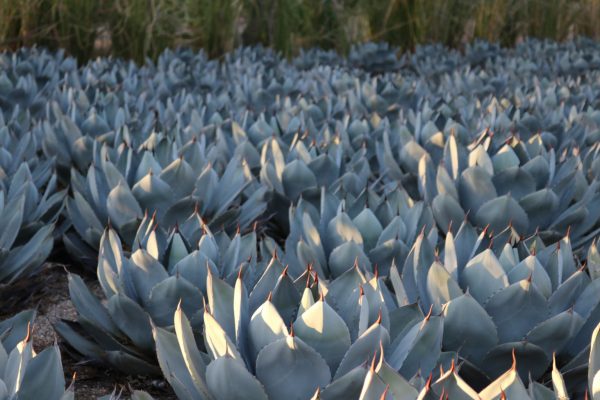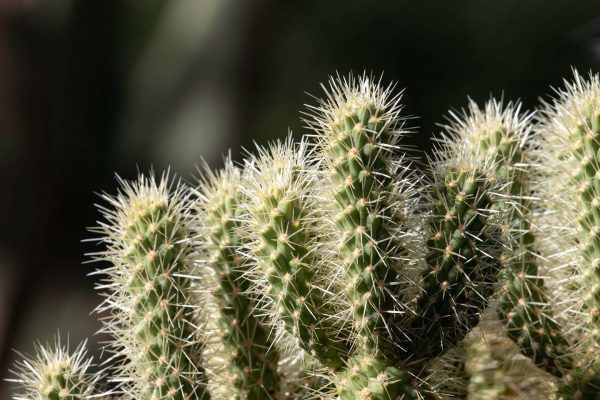
Teddy Bear Cholla is in the specimen beds between the café and the solar field. The nickname Teddy Bear comes from its appearance as a fuzzy plant, but the “fuzzy” is actually densely placed blond spines. Also referred to as Jumping Cholla, this skilled desert propagator uses a clever method to expand its territory. Barbs at the end of each spine allow the Cholla to grab on to anything passing with the slightest brush against it. It readily detaches from the main plant to hitch a ride on fur, t-shirts, or human skin. The touch need only be slight. Often the victim doesn’t realize a transfer has occurred. It’s easy to assume the spined balls jumped off the main plant or up from the ground where they blow around until settling to root in sandy or rocky terrain. Cactus Wrens and even Mourning Doves recognize the benefits of nesting in Cholla where predators risk serious injury if they pursue them. Small desert woodrats go a step further, using them to build a fortress around their burrow entrances.
The blooms are cup-shaped and range from a green to yellow color. They are sometimes tipped in tones of red.
Cholla’s range extends from the Mojave Desert in California, Nevada, and Arizona, down into Baja California and the Sonoran deserts of northern Mexico. It prefers to be below 3,000 feet in elevation, in sandy and rocky washes, and in bajadas (base of alluvial fans).
This smaller columnar cactus is in the specimen beds between the café and solar field and will grow to about 3 feet. It is a very attractive columnar cactus—perfect for small gardens or several planted in a larger space.
The varietal name grandiflora is no joke! It produces huge blooms and, with a variety of hybrids on the market, it is available in many colors, including pink, red, yellow, and bright fuchsia. When in bloom, they stop visitors in their tracks.
Previously named Lobivia grandiflora or Trichocereus grandiflorus.
Torch originates in Catamarca, Argentina.

Totem Pole is in the specimen beds between the café and the solar field. This columnar cactus is hard to miss with its protruding branches that resemble large bumps along its column. It is a slow growing, small cactus, with smooth spineless skin. It will grow branching stems low to the ground. Most visitors to Sunnylands are familiar with columnar and barrel cactus highlighted in old western movies, but have less exposure to the more unusual varieties. This unique specimen is a delightful departure from standard garden cactus and often is a point of conversation on garden walks.
Totem Pole is a night bloomer. The genus Pachycereus is Greek and Latin for “thick,” “candle,” “wax,” and “torch,” likely referencing their night-blooming nature. Many white-flowering desert plants provide nectar to migrating bats or moths, and so they bloom open at night and then close by the following midday. The flowers will be followed by the formation of sweet red fruit, with seeds called pitaya.
Its origins are in South America, including Brazil, Argentina, and Peru.
The best place to identify this species is in the specimen beds near the shuttle gate, though there is one in the specimen beds by the café. This cactus has a hefty stem diameter and a heavy covering of hair-like spines, which is where the common name Old Lady originated. Edward F. Anderson’s 2004 edition of The Cactus Family does not give this species a common name, but it is referenced elsewhere as Old Lady.
The Espostoa genus has not been studied extensively and many species will likely be reclassified through future phylogenics (gene study).
Greenish-white to red colored fruit will follow white bell-shaped flowers.
Distribution is northern to central Peru.

The specimen beds near the café have several Silver Torch cacti. The original planting included the species strausii, but clearly there are some other varieties from within the genus, and possible hybrids displaying a range of bloom color and spine distribution.
Silver Torch displays an abundance of spines on thin, cylindrical stems. It grows to about 10 feet. In the botanical genetics field, there is still some disagreement as to what should be included in the Cleistocactus genus, so as cactus are sorted more specifically along genetic lines rather than botanist observations, we will see new groupings in the future.
Red blooms can occur on Silver Torch Cactus throughout the year. At Sunnylands, the blooms emerge between red and orange, but generally the plant can flower with yellow and green blooms, too. The flowers barely open, and it is from this they get the name of the genus, Cleistocactus, as Kleisto in Greek means, “closed.” This tightly wrapped bloom may show some diversity, growing both straight and curved on different species. The blooms have a beak shape that closely accommodates the beaks of the hummingbirds that pollinate them. Birds with larger beaks would have difficulty. Flower design clearly shows preference when it comes to pollinators. In this case, it’s the hummingbirds that are preferred.
The genus of Cleistocactus extends throughout Argentina, Peru, and Bolivia.
San Pedro is planted throughout the gardens. You can see it in the specimen beds, in spotlight beds around the wildflower field, and the lower garden path. This is a columnar variety with very small spines spaced along the rib margins. In some cases, the spines are completely absent. Native at much higher elevations than Sunnylands, it nevertheless seems to thrive on the desert floor, as it is one of our most prolific bloomers.
The fragrant, white blooms open at night to await the nocturnal pollinators, bats, and moths.
The large, funnel-shaped blooms remain open the next morning, finding themselves the host of native bees who are completely engulfed by the long, pollen-covered stamens. The bees disappear into the bloom and re-emerge, speckled yellow.
San Pedro is native to Ecuador and Peru, where it is used extensively by indigenous cultures for medicine.

In the specimen beds between the café and the solar field, you will find the columnar Organ Pipe cactus. There are three in the bed closest to the café. Their flesh is dark green with red spines at the crown that turn gray down the column.
Another night-blooming giant, the Organ Pipe’s numerous branches can reach up to 26 feet. Its flowers are funnel-shaped and a pale cream color. The blooms open at night dispersing the scent of nectar that attracts moths and bats. Some come for the nectar and others for fruit—both exist simultaneously as the bloom period progresses. Insectivore species of Pallid Bat can be found hunting the pollinating moths foraging within the fruit. By late morning, the blooms close and the diurnal pollinators move in to take their turn as the day heats up and the fruits begin to ferment.
Distribution in Mexico includes Sonora, Baja California Sur, and Sinaloa. Arizona hosts the only wild range of this cactus in the United States, where it is designated as a national monument and UNESCO biosphere reserve.

Cardon can grow to 36 feet, and its spines are gray to white. There are three Cardon in the specimen beds nearest the solar field. They are still quite young and were less than 5 feet tall when planted during the original installation.
The Cardon is part of a family that consists of over 12 other large columnar cactus species under the genus Pachycereus (Greek for “thick” and “torch”). These botanical groupings for cactus are a bit fragile, and more phylogenic (genetic tracing) work needs to be completed. Not all cactus have had their genetic connections confirmed. In some groupings, they do not share the same taxonomic features and may later be determined to be unrelated. For now, they are grouped based on similar size and their candelabra structure. There are three species in the gardens that fall into this genus: Cardon, Fencepost, and Totem Pole.
When mature, they will display funnel-shaped, white flowers that will bloom both day and night, attracting multiple pollinators. This genus Pachycereus also has significant ethnobotanical uses by desert native cultures.
Distribution of Cardon includes the Sonoran Desert states of Sonora, Baja California, and Baja California Sur in Mexico. The Baja location is why it can be referred to as Baja Saguaro.
Blue Torch is in the specimen beds between the café and the solar field. A stunning columnar cactus, Blue Torch can range from a gray-blue to almost sea-foam blue in color. This species can grow to 20 feet, becoming tree-like with a center stalk and erect branches. Its golden spines will become gray with age.
The species azureus is synonymous with pachycladus, which is the name used in Edward F. Anderson’s 2004 edition of The Cactus Family.
The blooms of this genus are highly variable with some displayed as short and cup-shaped, and others reaching farther out to elongated bell-shapes. The bloom color is consistently creamy white.
The pachycladus is one of two distinct subspecies in Brazil, occurring in Bahia and Minas Gerais, south of the 10° south latitude. A similar cactus from the species pernambucoensis is found naturally in the northeast, north of the 10° south latitude.

The variety of Caribbean Agave at Sunnylands is ‘marginata,’ and its name refers to the striped margins of its leaf edge. It is in the specimen beds closest to the solar field. Late in life, it will begin to grow a stem that raises a rosette of leaves off the ground. Often this happens right before the plant blooms.
When it does bloom, this final act will require all of the energy it has been storing during its life. It will send up a 16-foot branched stalk that will bloom and then set bulbils (small, fully formed plants). These can be collected and propagated. If left alone, they will tumble down to root around the parent or blow off to bloom elsewhere and begin a new colony. Earlier during its life, it will also have grown offsets or clones that can replanted. In the wild, it may form a colony of these cloned versions of the parent plant. It is possible that the parent plant will be long gone from older colonies.
This is a native of northern Mexico, but it has an extensive range with varieties as far south as Costa Rica.
One of our most popular plants at Sunnylands is the truncated variant of Parry’s Agave. When visitors hear its common name is Artichoke Agave, the response is an instant head nod and verbal agreement—of course! It displays a tight, perfectly round rosette that is reminiscent of an artichoke bloom. Its arrangement in uniformed rows at Sunnylands draws the eye to its oval, blue-green leaves.
Like other parryi varieties, Artichoke Agave is versatile in garden design, pairing gracefully among wildflowers and perennials, or stealing the show in groupings. It adapts well to both desert floor and hillside gardens, making it a great choice for any space.

